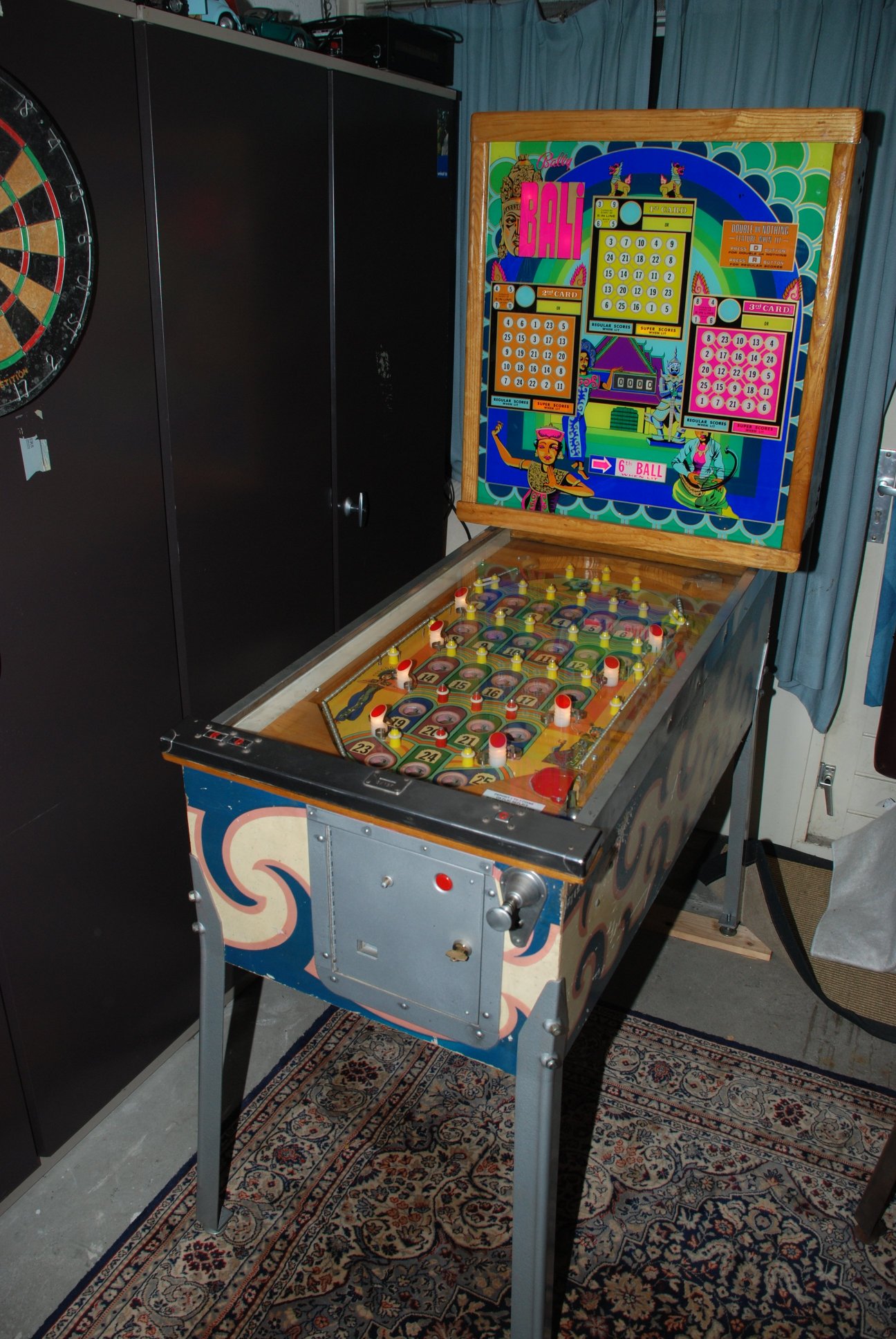
Ga terug naar de Homepage: Home
Flipperkasten:
Bingo : Bali
10 oktober 2015
de Bali
Bali
/ IPD No. 134
/ July 19, 1974 / 1 Player
Manufacturer:
Bally Manufacturing Corporation (1931-1983) [Trade Name: Bally]
Model
Number:
1025
Type:
Electro-mechanical (EM)
Specialty:
Bingo Machine
Notable
Features: Three Cards,
7 Coin Max, Super Scores, Corners Panels
Ja, u leest het goed.
Ik heb een Bingo machine toegevoegd aan de collectie.
Dat is raar. Want voor flipperfanaten is een Bingo iets afschuwelijks.
Een Bingo hebben of leuk vinden is vloeken in de kerk.
Dat begrijp ik wel.
Bingo en flipperen zijn in ongeveer de zelfde periode ontstaan.
Maar het waren twee totaal verschillende dingen. Flipperen was vooral behendigheid, de kast kennen en zelf door kennis en kunde de score be´nvloeden.
Bingo is gokken. Een spel waar je afhankelijk bent van hoe de ballen rollen en waar ze terecht komen, zonder dat je daar veel invloed op hebt.
Bingo is op die manier ook gok-verslavend terwijl flipperen dat niet heeft. Bij flipperen kun je immers alleen je eigen score verbeteren, een hogere score spelen dan je tegenstanders of zelfs de hoogste score van de kast maken.
Flipperen heeft ook veel meer een competitie effect, terwijl je bij Bingo in je eentje probeert meer geld aan de kast te verdienen dan je er in gooit.
Toch is het opvallend dat de IPDB ook de Bingo machines heeft opgenomen.
Soms is de benaming ook wel verwarrend, al is uit de geschiedenis goed te begrijpen hoe die ontstond.
Wat dacht u van "Bingo Pinball".
Het veld, waar allemaal gaten in zitten om de ballen te vangen, is ook bij bingokasten voorzien van postjes om de bal te be´nvloeden.
Vandaar ook hier PINball. Onderaan deze pagina vindt u een uitleg van Russ Jensen
Flippers en Bingos werden gemaakt door de zelfde fabrikanten (zoals Bally) en de techniek die gebruikt werd (spoelen, relais, rollen met contacten, stepperunits, etc) is vrijwel de zelfde.
Maar, de complexiteit van Bingo kasten uit de zestiger/zeventiger jaren is veel groter dan die van flipperkasten.
Immers, er moeten veel meer mogelijkheden afgehandeld worden, zowel tijdens het spel als na afloop om de winst te bepalen.
De Bali is dan nog een relatief eenvoudige kast met drie vaste kaarten , superscore als extra, een koopbare zesde bal en at random een cornerspel.
Als je bedenkt dat er 6 ballen gebruikt worden en er 25 gaten in het speelveld zitten, waarbij 3, 4 of 5 ballen op een rij in alle richtingen als resultaat telt, dan geeft dat wel heel veel mogelijkheden voor een eindresultaat.
Ofwel: je moet wel een razend slimme techniek hebben bedacht om dat allemaal uit te zoeken en aan de speler een prijs toe te kennen in de vorm van credits.
En dat is de reden dat ik een spelende Bingo wilde hebben.
Ik wil weten hoe en waarom het allemaal werkt.
Dus, daar ga ik me een beetje in verdiepen.
Een beetje maar hoor.
Want EM flipperkasten blijven mijn hobby.
Foto's

De kopruit is best goed om te zien.
Met name de kleursetting is mooi. Diep blauw dat via allerlei schakeringen naar groen en geel gaat.
In het donker is de verlichting rechts boven te weinig.
Eens kijken of daar misschien een lampje stuk is.
De uitgebeelde figuurtjes zijn wat minder geslaagd..
Met name de danseres links onder doet geen recht aan de schoonheid van de Balinese vrouwen.
Maar misschien konden ze niet beter................
 |
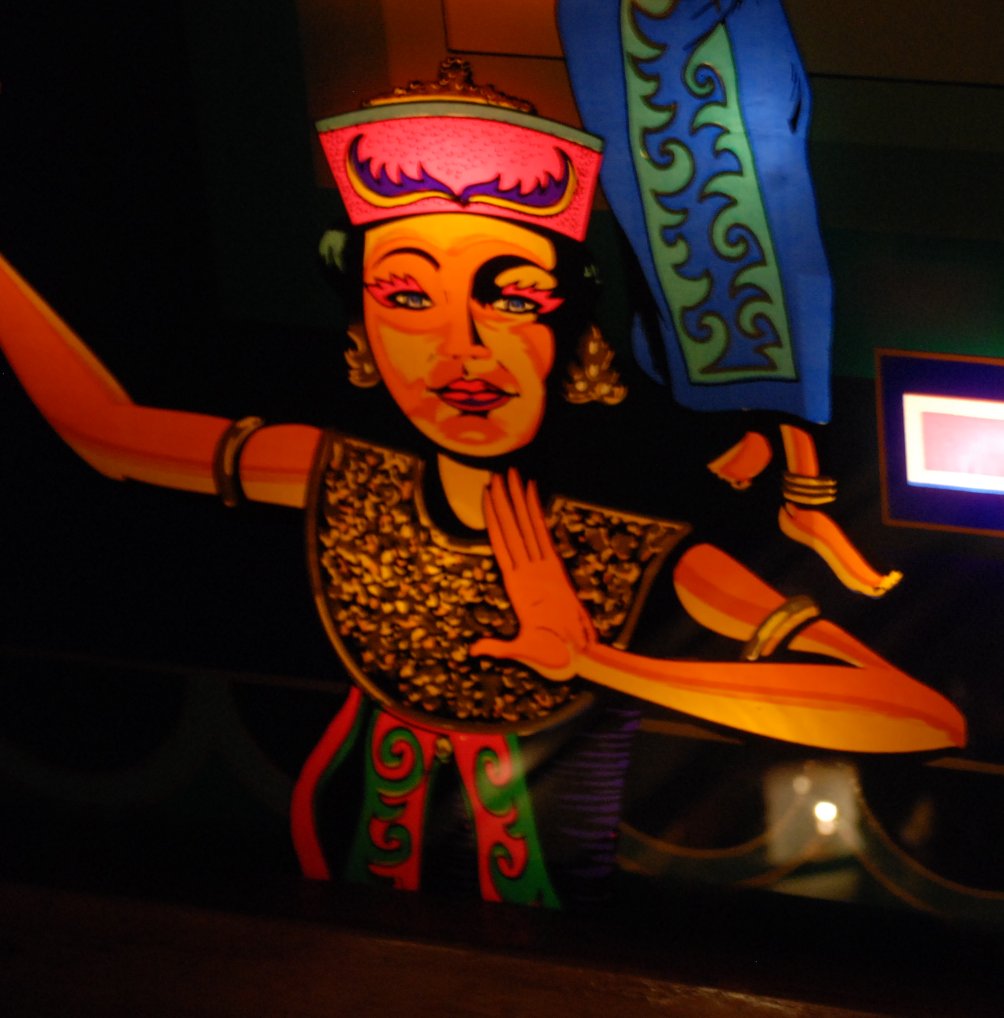 |
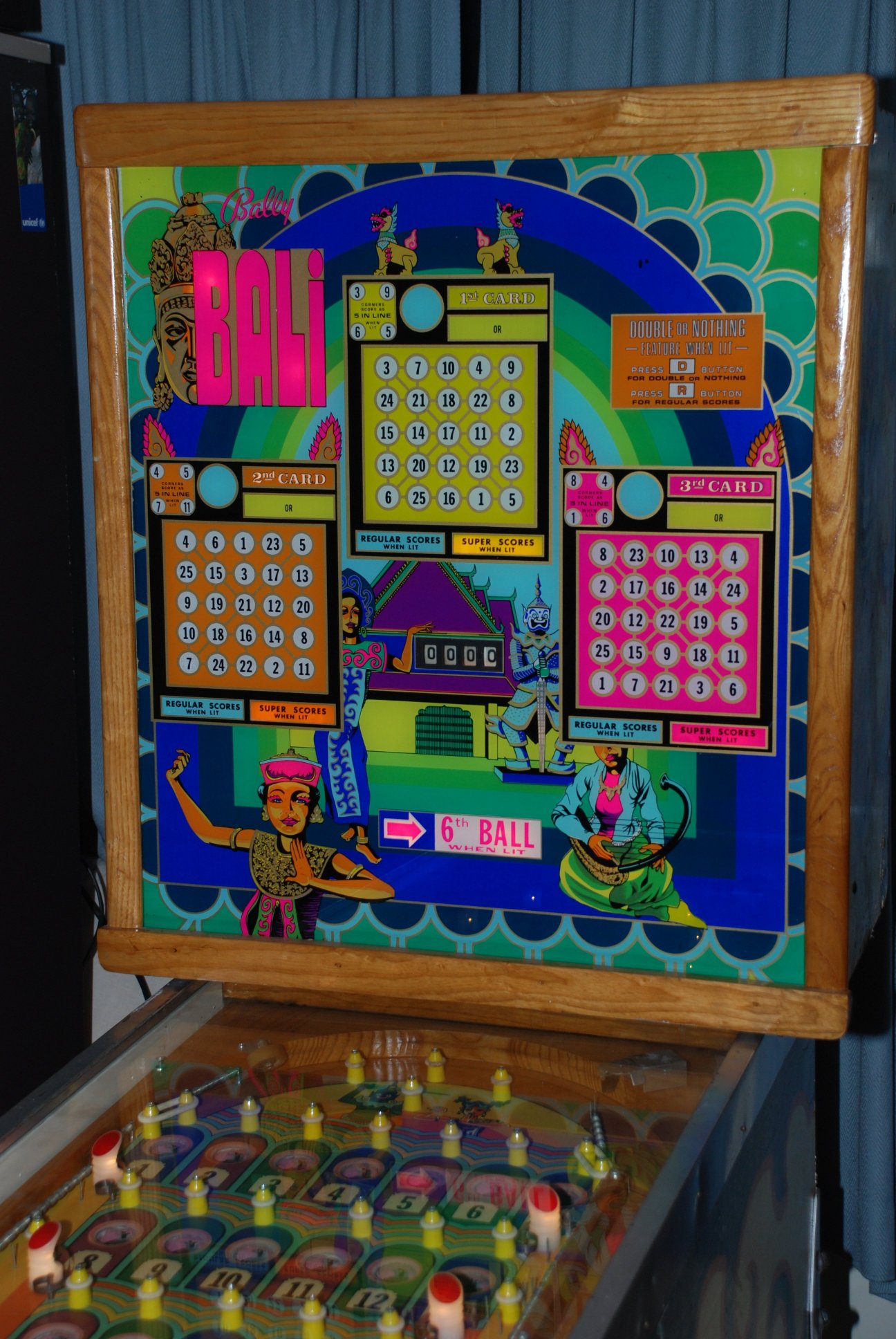
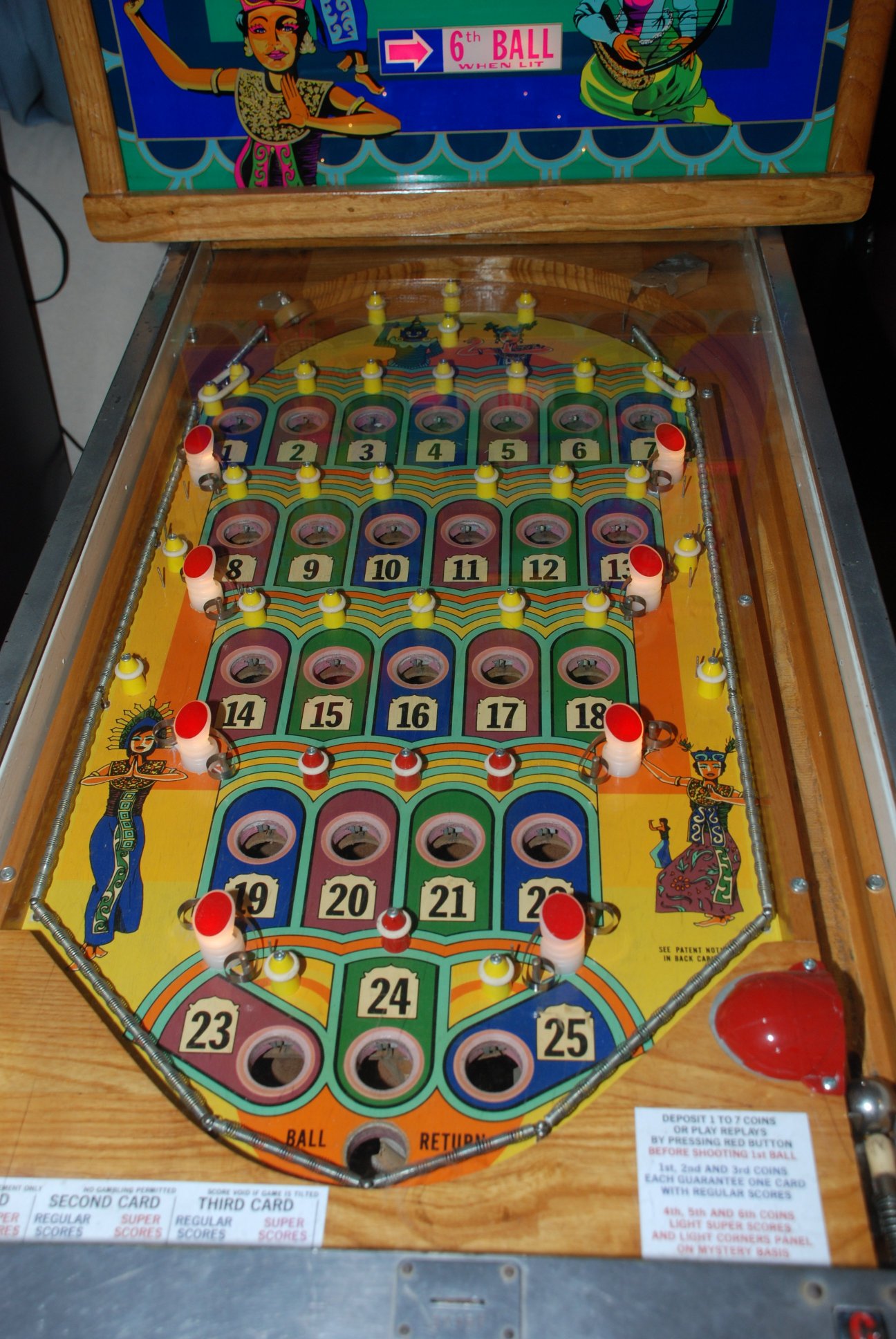
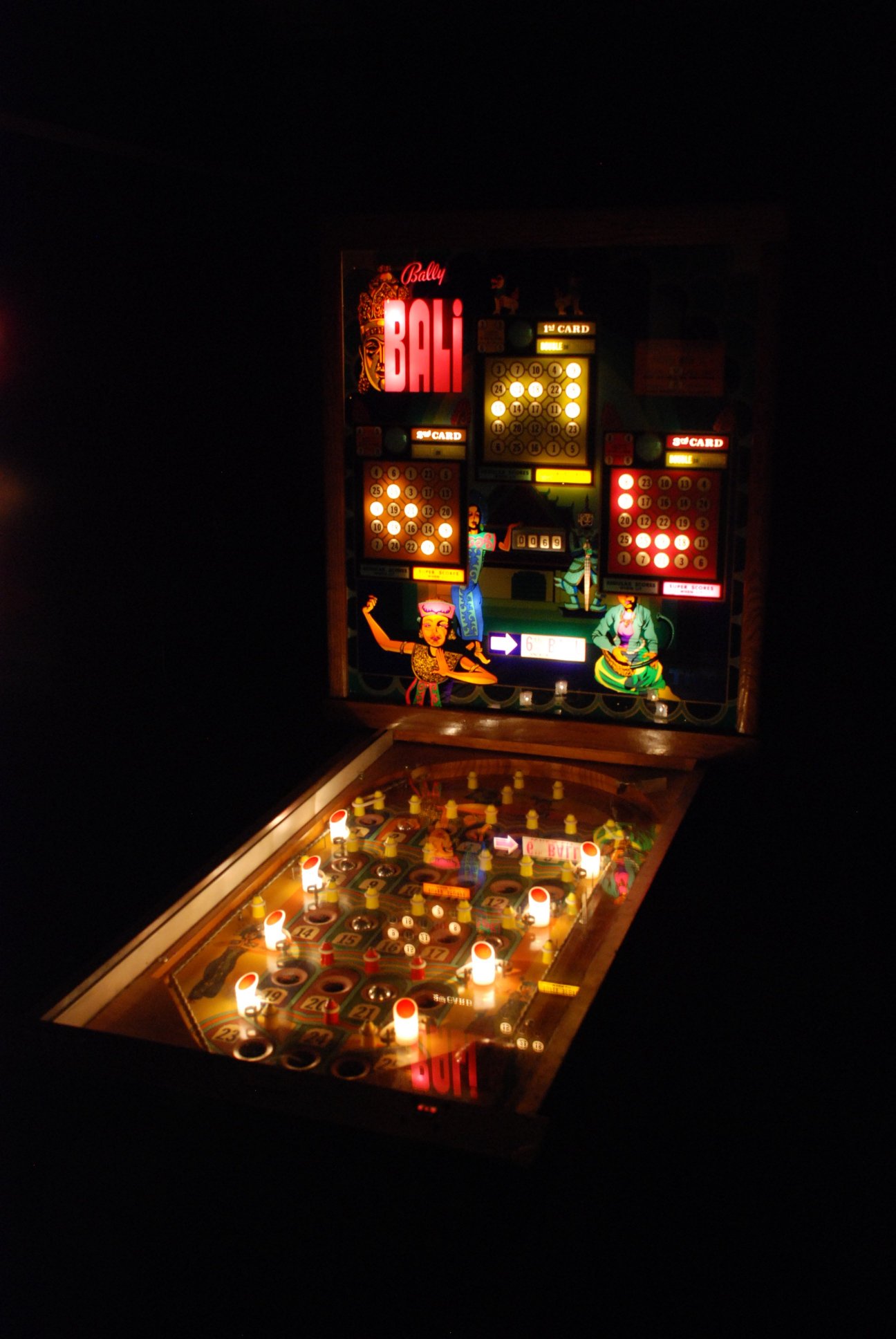
Het "cornerspel" treedt onverwacht op.
Alle hoekcijfers gespeeld geldt dan als 5 op een rij.
Het kan op 0 tot 3 kaarten tegelijk ontstaan.
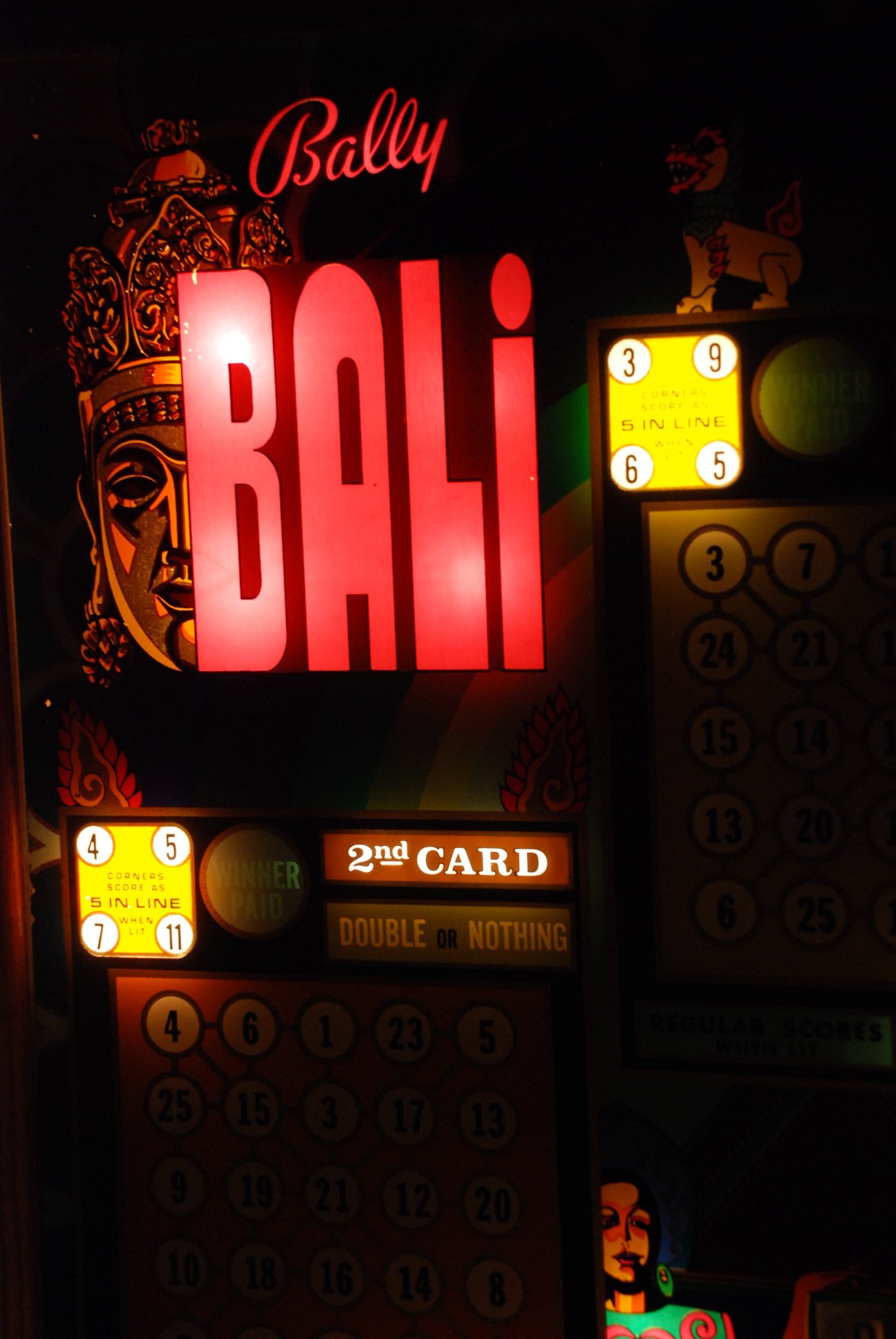
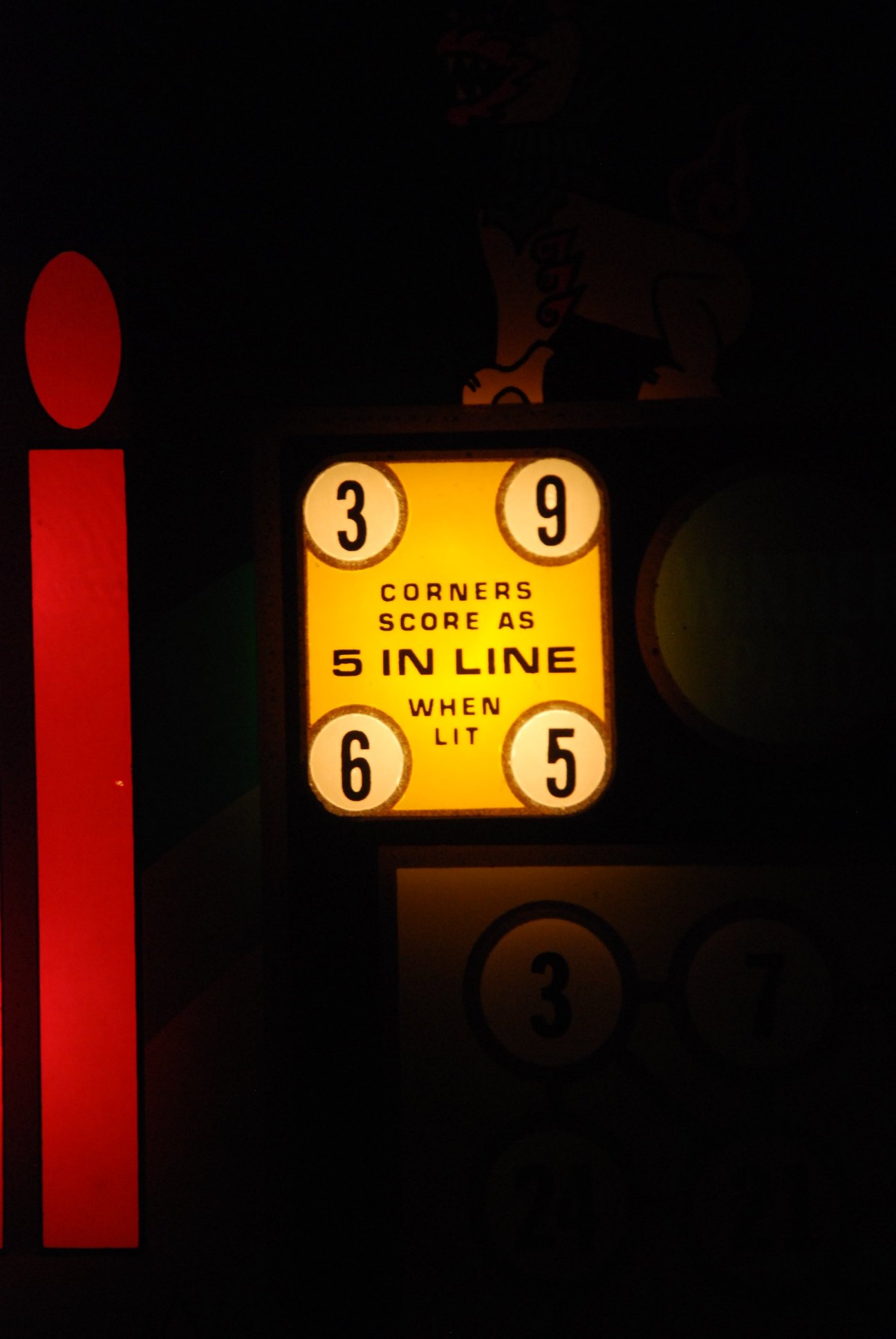
Uniek voor de Bali is dat je de 6e bal voor het spel begint al kunt kopen. Bij andere kasten moet je de 6e bal gaande het spel verdienen.
Het zal duidelijk zijn dat dit veel invloed heeft op het spel. Immers, met 6 ballen scoor je veel gemakkelijker 3 op een rij.
Dit betekent wel dat je de maximale inzet van 7 muntjes moet spelen. Alle voorliggende opties staan dan al aan (3 kaarten en voor elke kaart super score).
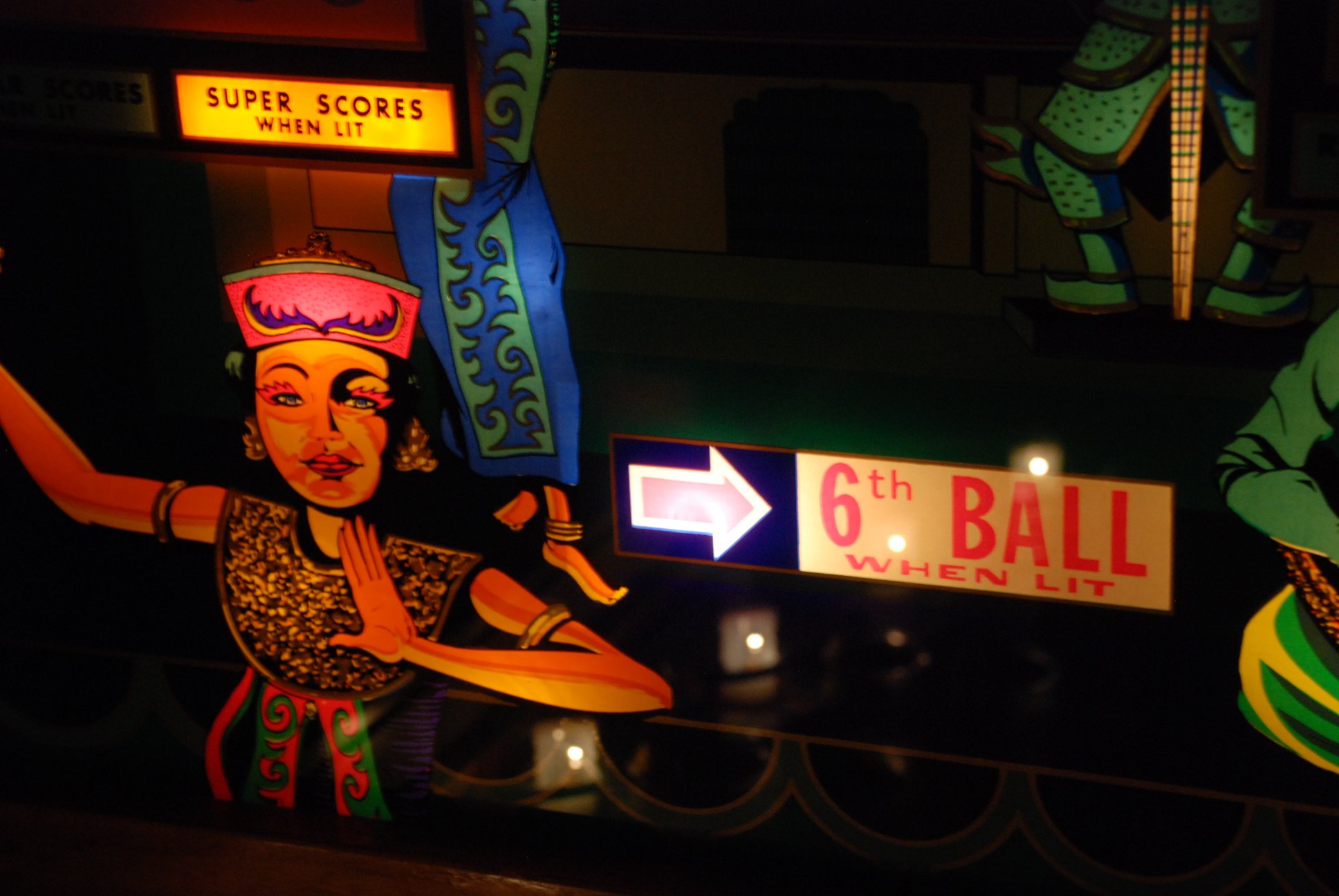
En wanneer je dan de puntentelling bestudeert kom je er achter dat het wel een beetje geldklopperij is.
Of misschien de zwaarste vorm van gokken op bingokasten.
5 op een rij spelen gebeurt haast niet, 4 op een rij natuurlijk iets vaker.
Meestal is het resultaat per kaart 3 op een rij.
Maar, hoewel je dus extra geld gestort hebt voor Super Score, levert je dat niks op !!!!
Maar o wee als je dan 5 op een rij speelt. Dan staat de kast vijf minuten te stampen om je credits te verhogen.
Da's pas gokken !!!!!!!!!!!!
Wanneer er credits op de kast staan op het moment dat deze wordt uitgezet, worden ze de volgende keer wanneer de kast wordt aangezet er weer afgehaald.
(Dit is anders dan bij flipperkasten!)
Dat is om te voorkomen dat anderen met jouw credits verder spelen. Het gaat hier dus duidelijk niet om een tegoed van aantal spelletjes, maar om geld.
Stel je hebt 200 credits gewonnen. En je wil cashen.
Dan moet je in gesprek met de cafÚbaas.
Die kan dan uitbetalen of je een IOY (I Owe You) geven.
Als je weer wil spelen kunnen de credits dan weer op de of een andere kast gezet worden. Vaak hadden kasten hiervoor een speciale voorziening waarbij de eigenaar met een sleutel credits kon ophogen.

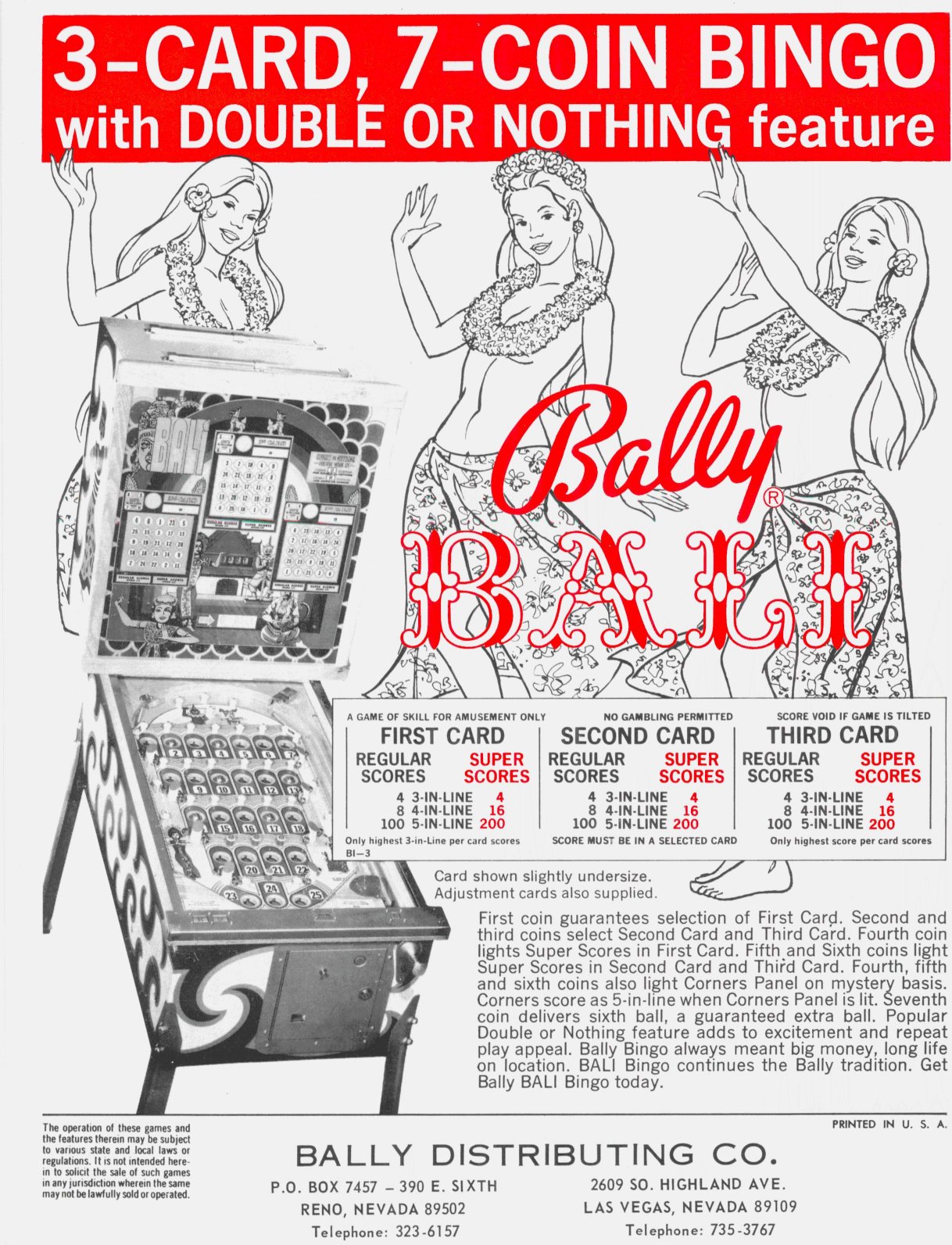
In 1951, a new type of pingame came into being to replace the "one-balls". One story, which was told to me by industry personage Bob Jonesi a few years ago, regarding the beginning of this new type of game goes something like this.
Lou Walcher, owner of the large San Francisco coin machine distributorship, Advance Automatic Sales, had an idea for a new type of pingame which used 5 balls ("one-ball" was definitely out) and scored replays by lighting numbers in a given pattern. He then challenged the industry to design games using his new idea. As a result the first "in-line" or "bingo" type pingames came into being
United's initial entry into this new field was a game called A-B-C which had a circular playfield (much like a roulette wheel) and three 5 by 5 number "bingo cards" on the backglass. Universal, actually a subsidiary of United, came out with 5-STAR, having a short rectangular playfield containing numbered holes and five 3 by 3 cards on the backglass. Bally's entry into this "derby" was BRIGHT LIGHT, which had a playfield about the size of a "one-ball" and six 5 by 5 cards. Well, Bally's format (as for playfield configuration and card size) finally won out, and games of that type became the new addition to the pingame industry.
Bally and United became the chief manufacturers of these new "in-line" games as they were first called, with a few being produced by Keeney, and even one by Williams. At first there seemed not to be much of a problem with shipping them under the Johnson Act, after all they were clearly not "one-balls" as five balls (and up to eight, as most allowed the player a chance to use up to three "extra balls") were actually used in each game.
But, before very long, these games were also being challenged in court as being "gambling devices" primarily due to the fact that they had no flippers (not much "skill factor") and because a player could win large numbers of replays which, in most locations, were paid off in cash by the proprietor of the establishment in which they were located. Indeed, I am sure "bingos" (as these games came to be called) were used for gambling more often than not.
Well, after many legal hassles, the 1957 "Korpran Decision" of the Supreme Court ruled that these "bingo pinballs" were "gambling devices" and thus subject to the Johnson Act. This severely cut back the use of these machines except in a few states, such as Tennessee and South Carolina, where they were legal. Bally continued to manufacture bingos, however, for many years to come to supply these states and foreign markets, even making improvements in the games, such as the popular "OK bingos" of the early Sixties, until the early Eighties when Tennessee (the largest U.S. user of these machines) outlawed them.
The Johnson Act also had its effect on "flipper games". Two characteristics used to define "gambling features" in coin machines, which showed up in many laws, were "a button to 'cancel' Free game credits" and "a meter to indicate the number of free games so canceled." In 1950 almost all flipper pinballs had these two features, so when the Johnson Act came along pinball manufacturers knew these features had to be eliminated from flipper games lest their shipment be banned by the new "law of the land".
Therefore, by 1951 or so, the infamous "knock-off button" was eliminated from most flipper pinballs. Incidentally, the "bingo pinball" manufacturers had found a clever way of getting around (at least for satisfying the "letter of the law") the "knock-off button" problem. The circuitry in these machines automatically ran the replays, indicated by the replay counter on the backboard, down to zero whenever power was applied to the machine. So, locations "paying off" replays would simply turn the game off and back on again, and the replays would be "reset" to zero without the use of a "button".
So, as you can see, by the early Fifties the Johnson Act had severely curtailed shipment of gambling machines such as slots and "one-balls", caused a new type of pingame (the well known "bingo") to be produced, and made it much more difficult (by the elimination of the "knock-off button") for people to gamble using flipper games. But this was not the end of the attack on pinball by the "crusaders", as we shall see.
It
was also in the early Fifties that some people in the coin machine industry
decided it was time to "clean up their act" lest their business be
hurt by the still existent anti-gambling forces. An organization, "the Coin
Machine Institute", was formed with harry Williams of Williams
manufacturing as its president. Many of the manufacturers, such as D. Gottlieb
and Co. (who got out of the "gambling business" in 1947 by eliminating
"one-ball" production), etc., joined this organization and began a
publicity campaign to show that "flipper pinball", and the other
amusement machines they made, were strictly for fun and had no connection
whatsoever with gambling. Others, such as Bally and United, continued to
manufacture "bingos" and other machines with a "gambling flavor".
(Source: http://jameswest.com/pinball/gambling.html)